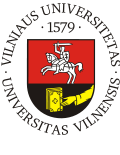Equipment
Glove Box
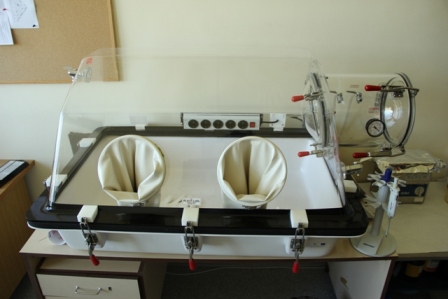
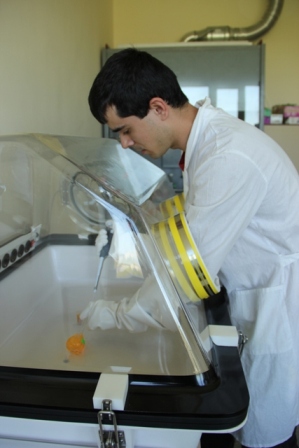
This glovebox is engineered to fit general laboratory isolation applications. It can be easily modified for specific uses. Unit is very handy for isolating sensitive research studies from a hostile exterior environment. This unit is compact, portable, lightweight and self-contained.
The Plas-Labs basic glove box is a single station and is economical, lightweight and portable. The basic glove box is engineered for general isolation applications in chemical, pharmaceutical, biotech and waste management laboratories.
• Clear one piece acrylic top with molded white base
• Double layered, closed cellular neoprene gaskets for airtight seal between top and base
• Adjustable SS clamps compensate for wear
• 8 in. O.D. ports with ambidextrous Hypalon® glove with SS O-rings
• Transparent transfer chamber (12 L × 11 in. I.D.) with adjustable vacuum gauge
• Four purge valves, two on transfer chamber, two on main chamber
• Multiple electrical outlet strip, CE UL and CSA approved
UV-VIS spectrophotometer JASCO V-670

V-670 UV-Vis Spectrophotometers
Dual-grating, dual-detector design to fully cover the range to 2700 nm
The V-670 double-beam spectrophotometer utilizes a unique, single monochromator design covering a wavelength range from 190 to 2700 nm (3200 nm option). The monochromator features dual gratings (automatically exchanged): 1200 grooves/mm for the UV/VIS region; 300 grooves/mm for the NIR region. A PMT detector is provided for the UV/VIS region and a Peltier-cooled PbS detector is employed for the NIR region. Both gratings and detector are automatically exchanged within the user selectable 800 to 900 nm range.
Streak camera
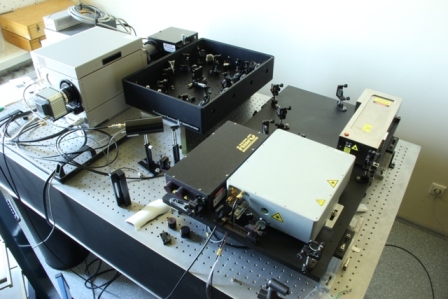

Streak camera is a device used to measure ultra-fast fluorescence. Several of the many advantages against other fluorescence measuring systems is that streak camera can register the entire data-set in very short time and it has very high time resolution – up to 0,2 ps. The principle of operation of the camera is similar to analog oscilloscope. Inside the device light is converted into stream of electrons, which is then converted back to light. The main concept of the camera is to bend the trajectory of the electrons with a varying electric field, which increases over time. Thus, the last electrons which arrive at the camera get bent the most. Since only one coordinate of the camera is used for time resolution (electron trajectory deviation), the other coordinate can be used to get spectral information. This allows gathering all the spectra with extremely good time resolution in one sweep. Streak camera is extremely useful if the sample is degrading fast or if we need to measure only the start of fluorescence decay (50-200 ps).
Our system uses 3W 1030nm "Pharos" as the main oscilator and "Hiro" harmonics genereator to produce laser pulses of ~80ps and 1030nm, 515nm, 343nm or 257nm. Frequency of the main oscilator (76MHz) can be reduced to 10kHz using Pockels cell.
Fluorescence lifetime spectrometer Edinburgh Instruments FL920

The FLS920-t is a modular, computer controlled fluorescence lifetime spectrometer.
Based on an L – geometry hardware configuration, the FLS920-t utilises the technique of Time Correlated Single Photon Counting (TCSPC) to measure time resolved luminescence spectra and luminescence lifetimes spanning the range from 100picoseconds to 10microseconds, with the accuracy and the resolution that only the technique of TCSPC can offer.
Features Include:
- Fluorescence lifetimes from 100picoseconds to 10microseconds
- High dynamic range and temporal resolution
- Time Correlated Single Photon Counting operation
- PC plug-in card for TCSPC
- Fully computer controlled through Windows (XP and VISTA 32 bit) software
- Full data reconvolution using a non-linear least square fitting routine
Pump-probe
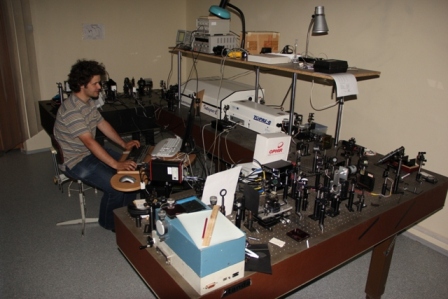
Pump-probe technique is probably the most widely used variation of ultrafast spectroscopy technique. Its concept is very simple and uses two short laser pulses: an intense pulse, ‘the pump’, which induces a photoreaction in the studied system and a weaker pulse, ‘the probe’, which monitors the corresponding change in the absorption spectrum of the sample. The delay of the probe pulse can be varied with respect to that of the pump and thus, the corresponding absorption change in the samples can be recorded at different time instances after the arrival of the pump pulse. Absorption change dynamics shows various processes that happen during the relaxation of photoexcited molecules.
The spectrometer is based on an amplified femtosecond Ti: sapphire laser Quantronix Integra-C generating 130 fs duration pulses at 805 nm at a 1 kHz repetition rate. Optical parametric generator TOPAS-C is used for tuning of pump pulses wavelength. We use a 2 mm thick sapphire or calcium fluoride plate in order to generate a white light continuum for probing differential absorption.
CARS microscope
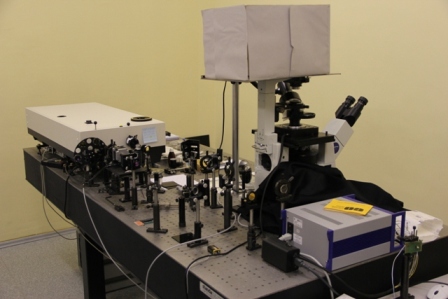
CARS microscopy is label free technique which contrast mechanism based on intrinsic molecule vibrations enabling chemical selective imaging. CARS is orders of magnitude more sensitive than spontaneous Raman. Nonlinear nature of CARS signal provides 3D imaging possibility without using confocal microscopy configuration. The Antistokes signal is blue-shifted and therefore is free from one-photon fluorescence background.
Our home-made CARS microscope setup includes a dual wavelength laser source and a scanning microscope. The laser consists of a picosecond frequency doubled Nd:YVO4 pump laser with the pulse repetition rate of 1 MHz equipped with a traveling wave optical parametric generator (OPG) which enables probing the 700 – 4500 cm-1 range of vibration frequencies. In our scheme for CARS implementation a signal radiation from the OPG (6 ps) is coupled with fundamental wavelength (1064 nm) and used as Pump and Stokes excitation beams, respectively.
Single molecule spectrometer
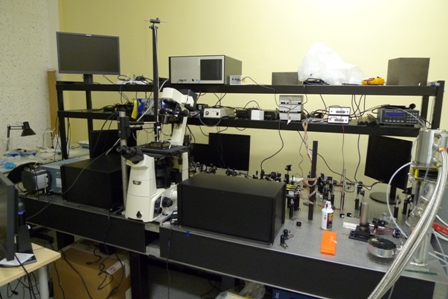
Single-molecule fluorescence spectrometer is for detecting fluorescence spectral dynamics from individual molecules immobilized on a surface or freely diffusing in solution. The setup can be operated in two excitation-detection configurations:
-
By exciting a wide sample field in total internal reflection (TIR) mode and detecting fluorescence signal from a number of individual molecules in parallel. Fluorescence image is split into two spectral components which allows observation of FRET in the donor-acceptor dye pair. The main advantage of this detection mode – the possibility of observation of a large number of molecules in parallel. The temporal resolution is limited, however, to approximately a video rate.
-
By exciting individual molecules in confocal mode and monitoring fluorescence from separate molecules one at a time. In this mode it is possible to acquire full fluorescence spectra. Temporal resolution for spectral acquisition is a few milliseconds, whereas if opting for the detection of only two spectral components, temporal resolution is up to a few tens of nanoseconds.
Moreover, in confocal mode it is possible to collect fluorescence bursts from molecules diffusing freely in solution. This way vast data statistics are collected relatively fast. By analysing such data with correlation analysis, it is possible to determine, for example, the efficiency of the excitation energy transfer inside the molecule of interest.


